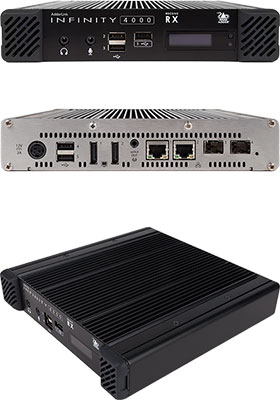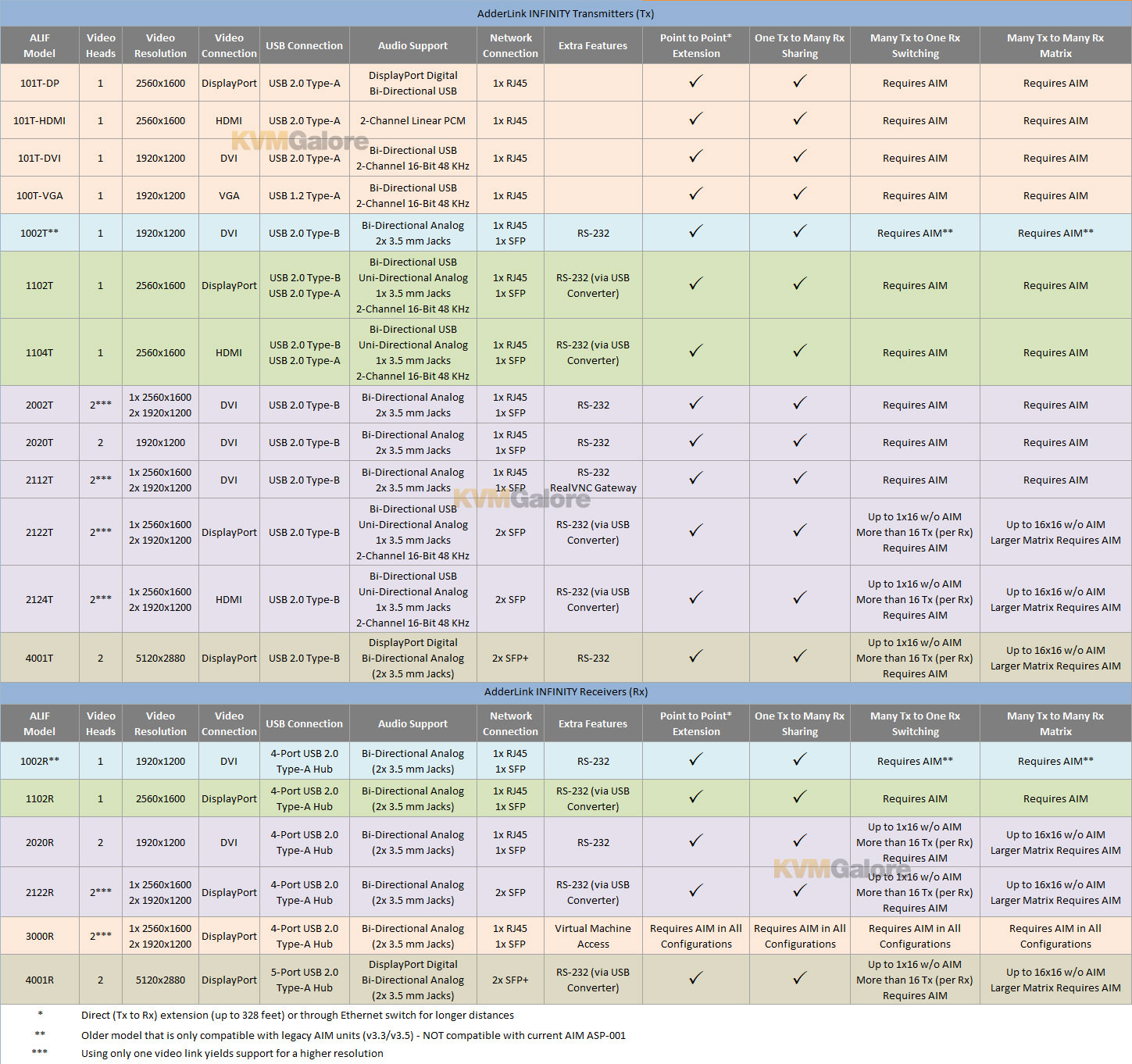Copyright © 2025 KVMGalore® - All rights reserved.

AdderLink INFINITY 4000
A dual-head 5K DisplayPort, audio and USB 2.0 IP KVM extension/switching/matrix system over CATx or fiber, using a standard 1~10GbE IP network
Read more below...

1) AdderLink INFINITY 4001 Receiver Model No. ALIF4001R-US  In stock
In stock

2) AdderLink INFINITY 4001 Transmitter Model No. ALIF4001T-US  In stock
In stock
A dual-head 5K DisplayPort, audio and USB 2.0 IP KVM extension/switching/matrix system
over a single fiber using a standard 10GbE IP network

• Dual CATx links at speeds up to 1GbE
• Support for dual CATx or fiber at up to 10GbE using optional SFP modules
• Dual-head 5K, video, audio and USB
• Pixel-perfect color accuracy
• Support for 240Hz frame rate at HD resolutions
• Bi-directional analog audio
• DisplayPort audio with 2, 4, 6 or 8 channels on both video heads (supports 5.1 and 7.1 audio)
• Adder's USB True Emulation for fast switching
• Support for advance diagnostic and troubleshooting tools
• Backwards compatibility with existing AdderLink INFINITY range
• Plug and play
AdderLink INFINITY 4000 (ALIF4000) is a dual-head 5K DisplayPort, audio and USB 2.0 fiber IP KVM system for A/V and KVM extension and switching over CATx or fiber using a standard 1~10GbE IP network.
AdderLink INFINITY 4000 delivers pixel-perfect, color accurate picture quality and USB 2.0 with fast switching. Fully compatible with the existing INFINITY range and supported by the trusted AdderLink INFINITY Manager (A.I.M.), AdderLink INFINITY 4000 can be used as a point-to-point extender or easily integrated into a wider matrix system, enabling KVM users to migrate to 4K without the need to rip and replace.
Configurations
AdderLink INFINITY can be configured to deliver the ultimate in system flexibility:
• Multicasting: The video output from any Transmitter can be multicast to many Receivers. The video data only exists once on the network, and each connected user (Receiver) can view the output simultaneously.
• Full Control: A user has full control of computer 1. The user is viewing the video output, listening to the audio, using a local USB peripheral and has full keyboard and mouse control.
• Mixed Receiver: Here a user is viewing the output video from computer 2 with full keyboard, mouse and local USB device control at the user's desk. At the same time, this user is listening to audio from Computer 1.
• A/V Only: A user position is configured to display video and play audio only. A/V selection may be from different sources.
• Share Mode: In share mode, two or more users have simultaneous access to a shared computer enabling collaboration or advanced control applications.
• Any to Any: In Any to Any mode, connections are fully independent enabling one user to access the first computer while another user accesses another computer etc. This mode supports large scalable matrix switching scenarios.
One-to-one configuration (extension)
The simplest configuration links one Rx unit to a single Tx unit, either by a direct link or over much greater distances via a 10GbE Ethernet network.
One-to-many configuration (also known as True Share or Reverse KVM)
Using multicast techniques, an unlimited number of Receivers can receive video and audio data streams from a single Tx unit. A maximum of twelve concurrent USB inputs (via multiple Rx units) are permitted to a single Tx unit.
Many-to-one and many-to-many configuration (requires AdderLink INFINITY Manager A.I.M.)
Each Rx unit can switch between different Tx units. Multiple instances of many-to-one and one-to-many configurations produce a highly flexible many-to-many installation.
ALIF and A.I.M.
Where multiple ALIF units are used on a network, Adder has developed the AdderLink Infinity Management (A.I.M.) server to allow comprehensive and secure central control of all Transmitters, Receivers and users.
IP Network-Based
Leverage standard 10GbE networking infrastructure to extend or matrix your computing resources to your users! AdderLink INFINITY 4021 units can be used as point-to-point extenders over CATx or fiber cable, or made into a flexible IP-based matrix using standard Ethernet switches and the AIM Manager. AdderLink INFINITY 4021 is the perfect solution for any application including for an office, campus, command center, video wall, editing studio, or as a digital signage solution.
Dual-head 5K screens over a single link
ADDERLink INFINITY 4021 (ALIF4021) can deliver two 5K screens over a single link
10-bit per color and HDR10
Allows greater color depth, supports both SDR10 and HDR10
Perfect digital video
Using the same encoding system as the other products in ADDERLink INFINITY (ALIF) range, the digital video is spatially lossless, with 1:1 pixel mapping, ensuring that the digital video you receive is the same as the one leaving your remote computer
Support for 5K resolution
5K video resolution supported for high resolution and ultra-wide video applications (5120x1440 @ 60Hz or 5120x2880 @ 30Hz)
High frame rate support
Refresh rates up to 240Hz supported for HD video resolutions
Audio capability
Multi-channel digital audio, via DisplayPort™, provides a high-quality immersive sound experience
High speed USB 2.0 with emulation and class control
AdderLink INFINITY 4021 supports transparent USB communication up to 480Mbps of USB devices from mice and keyboards to touch screens, graphics tablets, jog shuttles, joysticks and 3D explorers, alongside mass storage devices. True USB emulation technology also allows for fast keyboard and mouse or touch switching. For applications where security is of high importance, the system can disable the use of non-HID devices, meaning there is no need to physically block USB ports to prevent the use of mass storage devices.
Multigigabit Ethernet support
Multirate (1/2.5/5/10) GbE support enables premium video performance over standard CAT-6 cable up to 328 feet (100 m)
Enterprise-grade security
All AdderLink INFINITY units have built-in security measures compliant with universal enterprise grade security standards inlcuding AES 256 bit encryption and RSA 2048 bit public key authentication
Isochronous communication
Plug and play support for USB devices and third-party tools, such as Blackmagic® Design DaVinci Resolve® Color Grading Panels
Backward compatibility
ALIF4021 can integrate seamlessly into your existing ADDERLink INFINITY setup, replacing or working in conjunction with your existing ALIF endpoints
Unlimited extension distances
10GbE fiber-optic technology offers much greater extension distances over traditional CATx cables. Extension distance is also not limited to a single fiber cable length - If you need to extend further, simply add a 10GbE network device. This can be repeated many times for longer distances.
Redundant network operation
AdderLink INFINITY 4021 units are able to detect whether the network is in operation and can automatically change to its second network 10GbE SFP port if it detects a failure
Onboard diagnostics tool
Diagnostics tool maximizes uptime and assists with technical support enquiries by allowing the customer to troubleshoot network issues directly from the unit
Flexible and scalable
Each ALIF4021 unit can be configured as a simple extender or distributed KVM switch - each receiver can see up to 16 sources or can be connected to ADDERLink INFINITY Manager (AIM) to create a larger and more fully featured matrix
Rack-mounting option
AdderLink INFINITY 4021 units can be used at a desktop or be rack mounted two side-by-side in 1U with the optional RMK12 mounting kit (additional kits for different mounting methods are also planned for the future release)
Compatibility
All AdderLink INFINITY (ALIF) Transmitter (Tx) and Receiver (Rx) models are fully compatible with one another, as long they are running the latest firmware, subject to feature limitations that only exists on one end or the other.
• Limitation example #1: Tx supports 4K resolution but the Rx only supports HD resolution, so you'd only get HD video on the Receiver unit.
• Limitation example #2: ALIF100T (HD video, full speed USB) connected to ALIF4001R (4K video, high speed and transparent USB) unit, so you'd only get HD video and HID USB support.
Compatibility Notes
1) ALIF1000s are only compatible with legacy AIM units (v3.3/v3.5). The rest of the models are compatible with AIM/ASP as long as they are all running the latest firmware.
2) Only AdderLink INFINITY (ALIF) 2102/2122 and 4001/4021 models can be used in un-managed mode.
3) AdderLink INFINITY (ALIF) 3000s models require AIM - they cannot be used in Point-to-Point topology or in un-managed mode.
Operation Modes
There are two modes in which AdderLink INFINITY system can be deployed:
Un-Managed Mode: Tx and Rx units are deployed in Many-to-One (Switching) or Many-to-Many (Matrix) configurations without the use of AdderLink INFINITY Manager (AIM) server. Only ALIF2102/2122 and ALIF4001/4021 models support Un-Managed mode, restricted to no more than 16 Tx units connected to any given Rx.
Managed Mode: Tx and Rx units are deployed in a network along with AdderLink INFINITY Manager (AIM) server. Many-to-one and many-to-many configurations with multiple users (Rx) being able to switch between as many hosts/Transmitters as they have rights to require the use of AdderLink INFINITY Manager (AIM) server (with the appropriate number of licenses to match the number of end-points).
Topology Deployments
There are four ways to connect AdderLink INFINITY endpoints together:
Point-to-Point (Extension): one Tx to one Rx, via direct cable or via a network switch, with the IP address of the Tx being ‘hard coded' into the Rx unit.
Point-to-Point configuration can be deployed as a direct (Tx to Rx) extension (limited to a distance of 328 feet), or through an Ethernet switch for longer distances.
Point-to-Point configuration does not require to be managed with AIM server.
One-to-Many (Sharing/Reverse KVM): Using multicast techniques, an unlimited number of Receivers can receive video and audio data streams from a single Transmitter unit. A maximum of twelve concurrent USB inputs (via multiple Receiver units) are permitted to a single Transmitter unit.
When there are multiple Receivers connected to the same Transmitter, the Tx does not know (or care) how many Receivers it has connected, 2 or 222. One to many (one Tx to many Rx) is always multicast so the Tx just "gives" the frames to its network switch and the switch has to deliver it to every Rx that needs the frame using IGMP snooping and IGMP querier.
One-to-Many configuration does not require to be managed with AIM server.
Many-to-One (Switching): Multiple Transmitters are connected to one Receiver, so that a user (Rx) can use its console to switch between targets (Tx).
Many-to-One (switching) configuration requires to be managed with AIM server, with the exception of ALIF2102/2122 and ALIF4001/4021 models.
ALIF2102/2122 and ALIF4001/4021 models support Many-to-One (Switching) without the use of AIM server (aka: Un-Managed mode), with a limit of 16 Tx units connected to any given Rx unit (being that the Rx OSD only has 16 entries). There is no limit to the number of Tx and Rx units on the network in Un-Managed mode, however. There could be 100 Transmitters on the network, but each user (Rx) can only connect to 16 of those. So one user could have their own 16 computers and a second user can have their own 16 computers, or the two users can overlap, but they wouldn't be able to connect to all 100 host computers.
Many-to-Many (Matrix): Multiple Transmitters are connected to multiple Receivers, so that many users (Rx) can use their consoles to switch between many targets (Tx).
Many-to-Many (Matrix) configuration requires to be managed with AIM server, with the exception of ALIF2102/2122 and ALIF4001/4021 models.
ALIF2102/2122 and ALIF4001/4021 models support Many-to-Many (Matrix) configuration without the use of AIM server (aka: Un-Managed mode), with a limit of 16 Tx units connected to any given Rx unit (the Rx OSD only has 16 entries). There is no limit to the number of Tx and Rx units on the network in Un-Managed mode, however. There could be 100 Transmitters on the network, but each user (Rx) can only connect to 16 of those. So one user could have their own 16 computers and a second user can have their own 16 computers, or the two users can overlap, but they wouldn't be able to connect to all 100 host computers.










